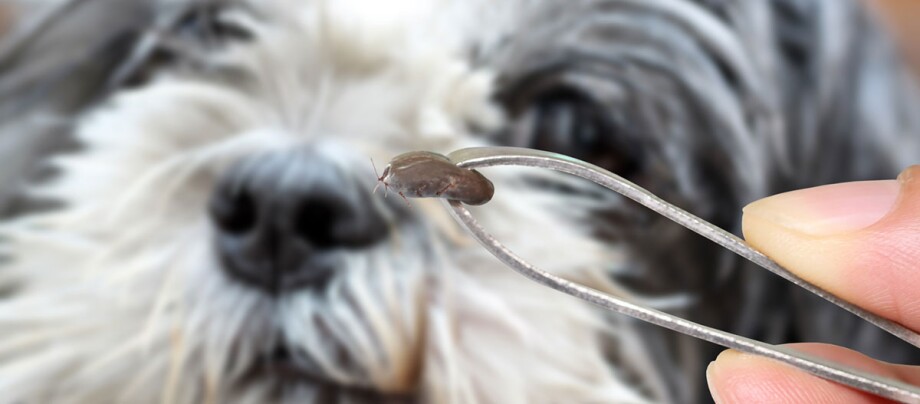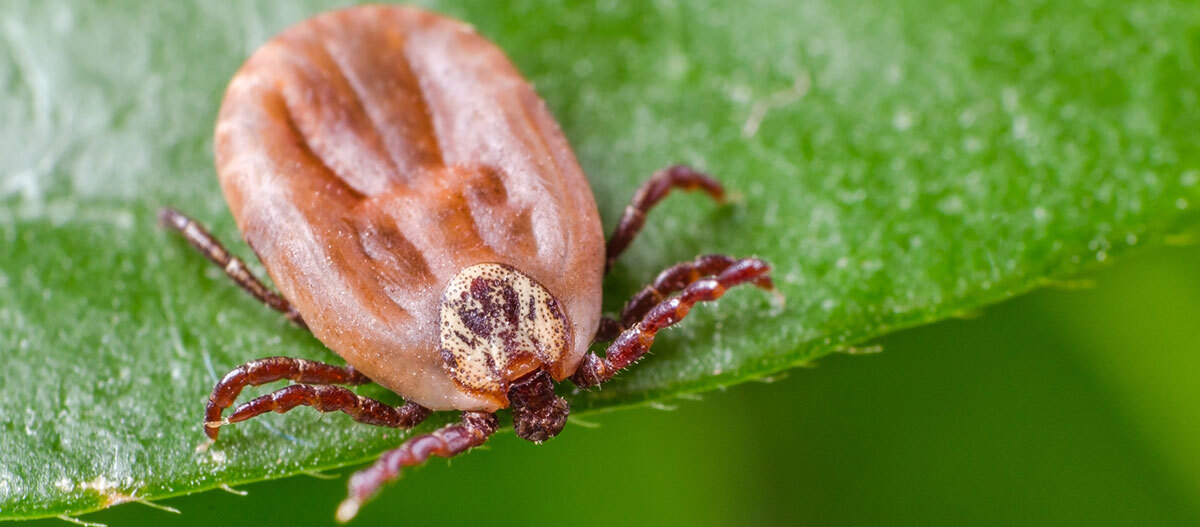Tick Bites on Dogs - How You Can Protect Your Four-Legged Companion
07.10.2022 - Reading time: 12 minutes

By the time the first flowers bloom and spring arrives, ticks are back in action, which is why it's important to ensure your dog is adequately protected as early as the first days of spring. In Germany, the common wood tick, the alluvial forest tick and the brown dog tick in particular lurk in the tall grass and undergrowth, waiting for their favourite victims: dogs. A tick bite can transmit dangerous diseases to a dog, such as tick-borne encephalitis (TBE), Lyme disease, Babesiosis, Ehrlichiosis or Anaplasmosis. The right tick protection, watchful eyes and emergency supplies will get you and your dog safely through the tick season. Read here how you can protect your four-legged companion!
- Ticks and tick bites in dogs: How do ticks get on to your dog?
- What happens when a tick bites your dog?
- Ticks and diseases are on the increase: What do you need to be afraid of with tick bites?
- The brown dog tick and its pathogens
- The castor bean tick and its pathogens
- The meadow tick and its pathogens
- Important note
- If the unhappy event has occurred: tick tweezers, tick hooks and tick loops
- Holidays with your dog - protection against ticks when abroad
- Information graphic
Ticks and tick bites in dogs: How do ticks get on to your dog?
As soon as it starts to get warm outside the much dreaded tick season breaks out. But ticks do not need a calendar – they just need a pleasant outside temperature of approx. 7°C to become active. If you live with your dog in a continuously warm area, or are on vacation together, then it is “tick season” all year round!
Ticks (Ixodidae) belong to the class of arachnids and to the subclass of mites that feed parasitically on the blood and lymphatic fluid of their hosts. You can recognise them by their triangular flattened body with eight easily visibly longer legs and a small mouth with mouth-parts. Colour-wise they shimmer in dark brown to red brown, some tick species have a grain on their back or a so called shield (hard-bodied ticks), other species have no exoskeleton (Argasidae).
If you look closely at a tick you can clearly see its mouth-parts, which are shaped pincer-like at the end of the head. The actual piercing tool lies hidden between these “pincers”, which the tick uses for its bloody meal while also holding on to the victim. To put it correctly, the so-called “tick bites” are actually ticks piercing through the skin.

Ticks go through numerous stages before they are fully grown: first they lay eggs outside the body of their victims (e.g. on the dog bed), from which larvae hatch. These develop into nymphs which eventually become adult, fully grown ticks.
The tick is an active parasite during all three stages that bites dogs, humans and other animals so as to develop further. You need more than just good eyes to discover the larvae or nymphs on the dog as they just appear as little dots on the skin. On the other hand, an adult tick can be seen relatively well just with the eyes with a bit of experience, providing your dog’s coat allows for easy viewing.
Once the tick is satiated with its bloody meal, it cannot be overlooked with its grey, bulging body. Female ticks which are full reach up to 3 cm in size.
Preferred locations of ticks are edges of woods and forests, meadows, clearings and parks. Here they sit on high grass stalks, low-hanging branches and in bushes, and reach out their forelegs which are equipped with special sensory organs to find passing victims. They are alerted through odour (sweat), vibrations, and changing CO2 content of the air (breath) and let themselves fall on the potential victim immediately. Certain tick species are active “hunters” and look for victims themselves.

Our dogs are especially affected by the tick plague because they like so much to rummage through tick territory. But, also humans and other animals like cats, hedgehogs, birds, mice, rats, sheep and many more are all prey for ticks. However, generally ticks are specialised for specific victims. that they prefer above all. This can be explained by the fact that ticks have developed sophisticated anaesthetics that are tailored to the immune system of their specific host.
Once it has landed on a dog the tick looks for a suitable spot to bite. Preferred are thin-skinned areas which are well supplied with blood like the head, lumbar region, ears and stomach.
Our fear of these little bloodsuckers is justified, because tick bites in dogs and humans transmit more pathogens than any other type of parasite, although mosquitoes are far ahead! Globally there are around 900 species of tick, of which only around 20 are native to Germany. However, over here dogs have to mainly deal with three tick species: the wood tick, the alluvial forest tick and the brown dog tick.
What happens when a tick bites your dog?
Once a tick has found a suitable place on your dog’s body, it will scratch the skin with its mouthparts and it will insert its proboscis into the resultant wound. This is how it sucks the accumulating lymph, cell fluid and blood. Hard ticks have a long proboscis with barbs which they use to “bite firmly” on to their host. During this process, the tick will immediately release a secretion which contains various active substances.
The secretion has the following active substances:
- An anaesthetic to keep the sucking process undetected.
- An anti-inflammatory to block the host immune system.
- An anticoagulant to prevent the wound from closing and to ensure blood flow.
- Ticks, that have a small long proboscis with barbs, give off a kind of adhesive substance which they use to stick to the dog’s body.
Certain pathogens like bacteria, viruses and other parasites can live in the bodies of ticks, using the tick as an intermediate host. The tick has infected itself with these co-habitants during a previous feeding from a sick victim. During its bloody meal, the tick releases undigested blood residues from its intestine into the dog’s wound. Thus the named pathogens change their host and can now lead to dangerous illnesses in the organism of the dog.
A blood meal of an adult male tick takes a few days and is relatively small as the male only needs the blood for its own feeding while waiting for a female. However, adult females can suck on the bite site for up to several weeks as they need more blood to produce eggs.
The risk of the dog being infected with pathogens is a given after approx. three hours. The tick needs this time to disgorge the undigested remains of its blood meal together with the pathogens from its intestinal tract into the wound of the host. The danger of infection increases with every hour the tick sucks the dog’s blood. So it is very important to remove the tick immediately as soon as you have seen it on the dog! Find out more about that here.
Ticks and diseases are on the increase: What do you need to be afraid of with tick bites?
Pathogens than can be transferred to your dog in the tick’s saliva should be taken very seriously, as they result in dog illnesses that are among the most serious canine diseases. For dogs in central Europe the most dangerous are the wood tick, the alluvial forest tick and the brown dog tick. The latter loves it warm and dry and loves dogs.
The brown dog tick and its pathogens
The brown dog tick was long viewed as “only” being native to the Mediterranean region. And specimens which were introduced into Germany were not considered to be viable. This belief has proven to be false in the last few years. As a result of global warming and the large number of imported dogs, the brown dog tick is on the increase and has been assimilated into many places in Germany and Switzerland.
The brown dog tick (Rhipicephalus sanguineus) is usually a reddish brown and is about 1-3 mm in size, although satiated females can be up to 1.2 cm in size.

The whole cycle from larvae (approx. 0.5 mm) to nymph (approx. 1 mm) to adult tick takes place on the dog’s body. The floor and dog-lying areas serve as an egg depository. The ticks can be very active and roam through their host’s living spaces to “hibernate” there. They can survive up to a year without a blood meal.
The dog tick can transmit Canine ehrlichiosis (Ehrlichia canis), anaplasmosis (Canine Cyclic Thrombocytopenia) and babesiosis from the species Babesia canis vogeli. All three are among the most feared canine diseases and are now found throughout Europe at varying levels of spread.
Ehrlichiosis – also known as “tick fever” and “Mediterranean disease” of dogs is a disease caused by bacteria of the Rickettsia type. They attack white blood cells (leukocytes) in the dog’s body and block the immune system that can then not attack them. Ehrlichiosis symptoms are very diverse, they start with a so-called acute phase which progresses to a subclinical, asymptomatic (silent) stage in two to four weeks and then to a symptomatic chronic stage.
Look for the following symptoms of the acute phase (up to three weeks incubation time after tick bite):
- Fever and fever episodes
- vomiting
- Fatigue
- Swelling of the lymph nodes
- Occasional muscle twitching
- Shortness of breath / heavy breathing
As ehrlichiosis has a silent stage it is not always recognised and tends to become a chronic illness. Babesiosis, from the species Babesia canis vogeli, runs a relatively mild course and is still rare in Central Europe, but is widespread as a cross infection with ehrlichiosis in the Mediterranean, France, North Africa and South America. See alluvial forest tick for information on babesiosis.
Anaplasmosis was counted as ehrlichiosis until recently. However, latest research has shown that the bacterial pathogens concerned with this disease are of the Anaplasma type. The symptoms are similar to ehrlichiosis.
At times the dogs do not show any visible symptoms apart from exhaustion. The Anaplasma bacteria attack special white blood cells – the granulocytes. The sickness worsens through cross-infections with babesiosis and ehrlichiosis.
There are no vaccinations for all three illnesses, prophylaxis is done exclusively via tick repellents.
The castor bean tick and its pathogens
The common wood tick (Ixodes ricinus) is somewhat larger than the brown dog tick and transmits pathogens of Lyme disease, early summer meningoencephalitis (TBE) and anaplasmosis.
While dogs contract TBE very seldom, Lyme disease is the most common tick-borne disease in dogs in our latitudes.
Borreliosis is caused by the bacteria of the genus Borrelia and the incubation period is between two weeks and five months. The symptoms of borreliosis are non-specific in the early stages and gradually get worse.
Pay close attention to:
- Recurring fever, loss of appetite and exhaustion (early stage)
- Joint pain and inflammation
- Muscle pain
- Lameness of front and hind legs
- Heart problems
The main symptom is a kind of reddish rash around the puncture site but this is seldom noticed in the dog’s thick coat (or with dark skin pigmentation).
In severe cases, neurological damage may remain, or the disease may take a chronic course. In some cases it ends fatally for the dog.
A borreliosis vaccination does exist but it only covers a few of the possible Borrelia bacterial strains. It is not considered sufficient and requires an additional tick prophylaxis anyway.
The meadow tick and its pathogens
The alluvial tick (Dermacentor reticulatus) is somewhat larger than the wood tick and can be well differentiated by the whitish marbled spine with a reddish-orange outer edge. It transmits babesiosis pathogens, the Babesia canis canis, which lives in red blood cells (erythrocytes) and destroys them. Thus, first symptoms of this disease is anaemia (anaemia of the blood). Initially babesiosis was a “Mediterranean disease”, however, the pathogens are already at home now in Germany, the Netherlands, Poland and Switzerland. The pathogen is considered to be particularly strongly disease-causing. Babesiosis is also known as “dog malaria”. Untreated, it leads to the death of the dog.
In the beginning the symptoms are non-specific:
- High fever or bouts of fever
- General dullness and weakness
- Pale yellowish mucous membranes
- Red to green-brown urine
- Kidney failure
- Digestive and circulatory disorders
- Edema
- Central nervous symptom disorders
Please note
The information given in this guide is not intended to be a substitute for a visit to the vet. It should not be used as the sole basis for health-related decisions. A vet should be consulted in case of illness and use of medication in animals.
If the unhappy event has occurred: tick tweezers, tick hooks and tick loops
It is difficult for dog owners to stop their four-legged friends from wandering around in undergrowth and in meadows as well as under bushes, particularly as these places are a dog’s natural habitat and give him a great sense of joy. For this reason, it is not only necessary to exercise caution; it is also necessary to check your dog thoroughly after every walk, particularly during the months of March to October.
This thorough checking involves searching your dog’s fur carefully for parasites. It is best to brush your dog thoroughly and then to rub him/her with a white, slightly damp cloth. Keep a lookout for brown to reddish-brown mites or specimens which are firmly attached to the head, abdomen, groin areas and ears and do not forget the gaps between the toes. If you have already discovered a firmly attached tick, you can use a special device for skilled removal of the parasite. Remove the tick immediately. In a pet shop, you will find many different tick removal devices, e.g. tick tweezers and tick loops. Experts recommend tick hooks, which are available in two different sizes. These can be used to remove ticks from sensitive areas of your dog’s body in an efficient and painless way.
Holidays with your dog - protection against ticks when abroad
If you want to travel abroad with your dog, you should protect your four-legged friend from any parasites and pathogens which are widespread there. What these parasites are and how you can protect your dog against them is something which Professor von Samson-Himmelstjerna will explain to you in this interview.
Dog’s symptoms after tick bite:
- Bouts of fever
- vomiting
- Loss of appetite
- Exhaustion
- weight loss
Warning symptoms are also:
- Yellow to bloody urine
- Movement disorders (ataxias) and changing symptoms of lameness
- Aching legs
- Bleeding and oedemas
If you notice these symptoms, take your four-legged friend to a vet immediately.


